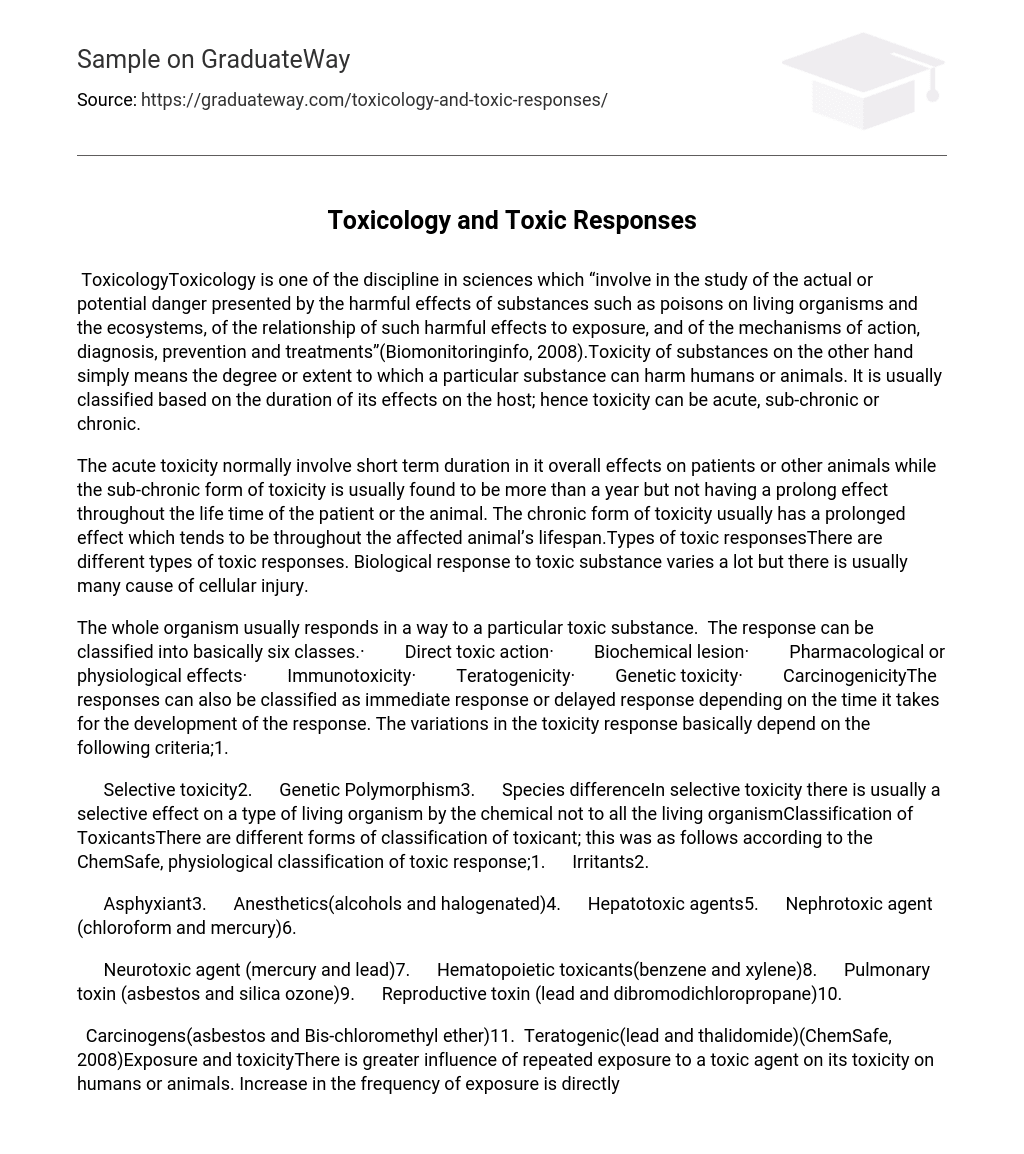ToxicologyToxicology is one of the discipline in sciences which “involve in the study of the actual or potential danger presented by the harmful effects of substances such as poisons on living organisms and the ecosystems, of the relationship of such harmful effects to exposure, and of the mechanisms of action, diagnosis, prevention and treatments”(Biomonitoringinfo, 2008).Toxicity of substances on the other hand simply means the degree or extent to which a particular substance can harm humans or animals. It is usually classified based on the duration of its effects on the host; hence toxicity can be acute, sub-chronic or chronic.
The acute toxicity normally involve short term duration in it overall effects on patients or other animals while the sub-chronic form of toxicity is usually found to be more than a year but not having a prolong effect throughout the life time of the patient or the animal. The chronic form of toxicity usually has a prolonged effect which tends to be throughout the affected animal’s lifespan.Types of toxic responsesThere are different types of toxic responses. Biological response to toxic substance varies a lot but there is usually many cause of cellular injury.
The whole organism usually responds in a way to a particular toxic substance. The response can be classified into basically six classes.· Direct toxic action· Biochemical lesion· Pharmacological or physiological effects· Immunotoxicity· Teratogenicity· Genetic toxicity· CarcinogenicityThe responses can also be classified as immediate response or delayed response depending on the time it takes for the development of the response. The variations in the toxicity response basically depend on the following criteria;1.
Selective toxicity2. Genetic Polymorphism3. Species differenceIn selective toxicity there is usually a selective effect on a type of living organism by the chemical not to all the living organismClassification of ToxicantsThere are different forms of classification of toxicant; this was as follows according to the ChemSafe, physiological classification of toxic response;1. Irritants2.
Asphyxiant3. Anesthetics(alcohols and halogenated)4. Hepatotoxic agents5. Nephrotoxic agent (chloroform and mercury)6.
Neurotoxic agent (mercury and lead)7. Hematopoietic toxicants(benzene and xylene)8. Pulmonary toxin (asbestos and silica ozone)9. Reproductive toxin (lead and dibromodichloropropane)10.
Carcinogens(asbestos and Bis-chloromethyl ether)11. Teratogenic(lead and thalidomide)(ChemSafe, 2008)Exposure and toxicityThere is greater influence of repeated exposure to a toxic agent on its toxicity on humans or animals. Increase in the frequency of exposure is directly related to the toxicity of most substances. The frequency is also time related for instance if there is an exposure of 2 consecutive exposure for a duration of 12hrs a day is quite different from three consecutive 8 hour exposure.
This aspect of the relationship between exposure and toxicity should be greatly considered when planning the work scheduled for workers at risk of exposure to toxicity is quite important to prevent the life threatening effects of such chemical substances.There are different phases to exposure to toxic agent; these are the acute exposure and the chronic exposure. The acute exposure describes a single or repeated exposure over a short period of time while the chronic exposure describes a repeated and continuous over a long period of time. The acute and chronic exposure tends to show different symptoms in the affected patients.
For instance the acute effect of exposure to lead is colic while chronic effect of exposure to cause wrist drop.Toxicity testingTesting normally begins when a new drugs or chemical is being manufactured. The testing is usually done on rodents. The objective of the process is to determine the lethal dose of the compound.
The lethal dose is usually refer to as the LD 50 and the test the LD50 test.Testing can be considered under the following subheadings;· Acute toxicity testing· Repeat-dose toxicity testing· Long-term toxicity testing· Late-stage toxicity testing Acute toxicity testingThe whole process of toxicity testing normally commence with this step. The rodents or any other animal to be used are given a single dose of the compound or chemical to be tested with the aim to determine the range between the dose that causes no adverse effect and the dose that is life threatening. The animal is usually monitored for 14days after injecting them with the compound.
The result can then be analyzedRepeat-dose toxicity testingThis is the second testing stage. All compounds that are negative to the above test can then be further scrutinized further for toxicity. This can help determine the effects of such compounds on the body as a whole, which is the relationship of the dose of the compound to the response of the organism. The information provided by this stage is useful in estimation the safe starting dose for human clinical trials.
Long-term toxicity testingIt is usually done for a period of 30days which is then followed by the 6months duration study on the rodent and non rodent animals. The result from the testing can then be review. Most times it tend to give the idea of what can be expected when the drugs is later administered to humans. It also helps determine the effect of such compound on the animal genomePhases of ToxicosisToxicosis is generally classified under 3 main phases:Phase 1: there is an early sign within an hour of toxic exposure; there is drunken-like appearance with ataxia (an uncoordinated movement).
There may be a period where there are no symptoms.Phase 2: it usually develops in about 12 to 24 hours after the ingestion of the toxic compounds and it is characterized by heart failure.Phase 3: symptoms such as vomiting, neurological symptoms like headache, depression and the patient might lose his or her appetite and also refuse to eat. There can be kidney failure and the can be death within 1-3 days after exposure to the toxic compounds ReferencesBiomonitoringinfo, (2008).
Glossary of Terms and Concepts Associated with Biomonitoring.Retrieved 19, Sept 2008 from www.biomonitoringinfo.org/glossary/glossary.
html ChemSafe, (2008). Physiological Classification of Toxic Responses. Basic HazardsRetrieve 19, Sept 2008 from http://learn.caim.yale.edu/chemsafe/references/classification.html





